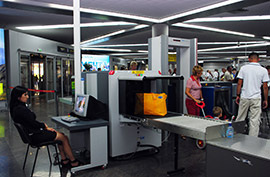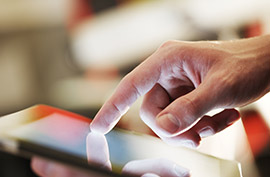 Airport security is a necessary nuisance travelers must accept if they wish to be able to fly around the world safely. The best any flier can hope for is to get through security as quickly and painlessly as possible. That means being prepared and avoiding mistakes that will slow you and everyone else down, and maybe even get you into trouble with the TSA.
Airport security is a necessary nuisance travelers must accept if they wish to be able to fly around the world safely. The best any flier can hope for is to get through security as quickly and painlessly as possible. That means being prepared and avoiding mistakes that will slow you and everyone else down, and maybe even get you into trouble with the TSA.
Our 10 suggestions of what not to do at the security checkpoint will make you a savvier flier, capable of breezing through airport security like a pro.
1. Don't bring more than 3.4 ounces of any liquid.This may be obvious to regular fliers, but even though the so-called 3-1-1 rule went into effect back in 2006, infrequent travelers still show up with full-sized bottles of shampoo, perfume and more in their carry-on bags. Each time this happens, a TSA agent has to pull the bag off the security belt, call the passenger over, search the bag, scold the passenger and throw the bottle out, thus slowing the security line down -- and earning the offender annoyed head shakes from those stuck waiting.
However, as of January 2014 there is a new exception to the rule for those flying to the United States via a connecting flight from overseas. Until recently, any duty-free liquid items bought at the originating airport would have had to be moved into checked luggage at the connecting airport before going through security. Now, passengers may bring these bottles into the United States so long as they are still sealed in the "secure, tamper-evident bags" (STEBS) they were originally packaged in. Other exceptions to the 3-1-1 rule include medications, breast milk and baby formula.
For more information on what you can and can't bring through airport security, check out our Airport Security Q&A.
2. Don't leave liquids and gels deep in your carry-on.One surefire method to slow a security line down is to be stuck digging through your carry-on for items that need to be placed in the bin individually. Putting travel-sized liquids into a clear, see-through quart-sized bag is not enough. Keep it stored in a handy place so all you have to do is unzip your carry-on and grab it.
3. Don't forget to have your boarding pass and ID in hand.Similar to the above, you don't want to be pulling out your wallet to grab your ID while you're standing in front of the security agent. Do that while waiting in line or, better yet, before you even get in line. You'll not only make things faster for yourself and those behind you; you also won't annoy the security agent.
 Seven Ways to Score Airport Lounge Access
Seven Ways to Score Airport Lounge Access
If you haven't caught on to our "be prepared" mantra yet, here it is again. The best way to move through security as fast as possible is to have everything you need out and ready to be placed on the conveyer belt as soon as you get there. If you're wearing a belt or watch, take them off while you're in line. Same thing with your jacket and even your shoes if possible, especially if they've got shoelaces -- at the very least have your laces untied so all you have to do is slip your shoes off. Caveat: Seniors over the age of 75 may leave their shoes and light jackets on, and kids under 12 also can leave their shoes on.
5. Don't remove items you don't need. One of the most common mistakes people make at airport security is to take out all their electronic devices to be X-rayed separately. You don't need to do this. According to the TSA, only electronics the size of a standard laptop or larger -- like a PlayStation, Xbox or Nintendo -- or video cameras that use video cassettes must be removed from their carrying cases and X-rayed separately. Tablets, e-readers, handheld DVD players and phones can remain in your carry-on. Just make sure they're out of your pockets!
One of the most common mistakes people make at airport security is to take out all their electronic devices to be X-rayed separately. You don't need to do this. According to the TSA, only electronics the size of a standard laptop or larger -- like a PlayStation, Xbox or Nintendo -- or video cameras that use video cassettes must be removed from their carrying cases and X-rayed separately. Tablets, e-readers, handheld DVD players and phones can remain in your carry-on. Just make sure they're out of your pockets!
While not all airports have dedicated security lanes for elite fliers who move efficiently or those who need more time like families, many of the busiest airports do. Make sure you keep your eyes open for lane signs, so you don't get in the wrong one. Choosing the wrong lane can either mean wasting time behind a family of five or holding up everyone else if you're the one who needs extra assistance.
 Does Your Flight Attendant Hate You?
Does Your Flight Attendant Hate You?
Most large airports have multiple checkpoint entries for any given terminal, and some may be busier than others at certain times of day. The TSA offers travelers an app through which you can check security wait times. Just be sure you actually can reach your gate via the checkpoint you've selected.
8. Don't give the security folks a hard time.You may think your trial shampoo bottle is smaller than 3.4 ounces, or maybe the last time you went through security, no one cared that your mascara wasn't in a clear bag. All that matters is what they're telling you this time. While the particular TSA agent demanding you give up your "contraband" very well may be in the wrong, at that moment he or she has all the power and arguing isn't going to get you anywhere but possibly detained.
9. Don't joke about national security or bombs.Technically, cracking jokes about national security at an airport is not illegal, but that doesn't mean you can't get in trouble for doing it. Take the case of Edgar Fabian Navarrete, who was arrested in September 2013 after joking that his friend had a bomb while they were at the Miami International Airport. Another man, Frank Hannibal, was arrested at LaGuardia Airport for joking that the TSA was looking to confiscate his explosives while screeners were double-checking a jar of peanut butter. You may think your joke is funny or harmless, but remember, the TSA has no sense of humor when it comes to doing their jobs. Always err on the side of caution.
 Confiscation Confidential: Weirdest Items Taken by the TSA
Confiscation Confidential: Weirdest Items Taken by the TSA
The TSA's PreCheck program is a risk-based prescreening system that allows frequent fliers to apply for access to a restricted -- and faster -- airport security lane. The application process is essentially an in-depth background check, but once cleared, PreCheck fliers no longer have to remove their belts, shoes and lightweight jackets, nor must they place their 3-1-1 compliant plastic bag and laptop in separate bins. PreCheck lanes are currently available at more than 100 airports throughout the United States.